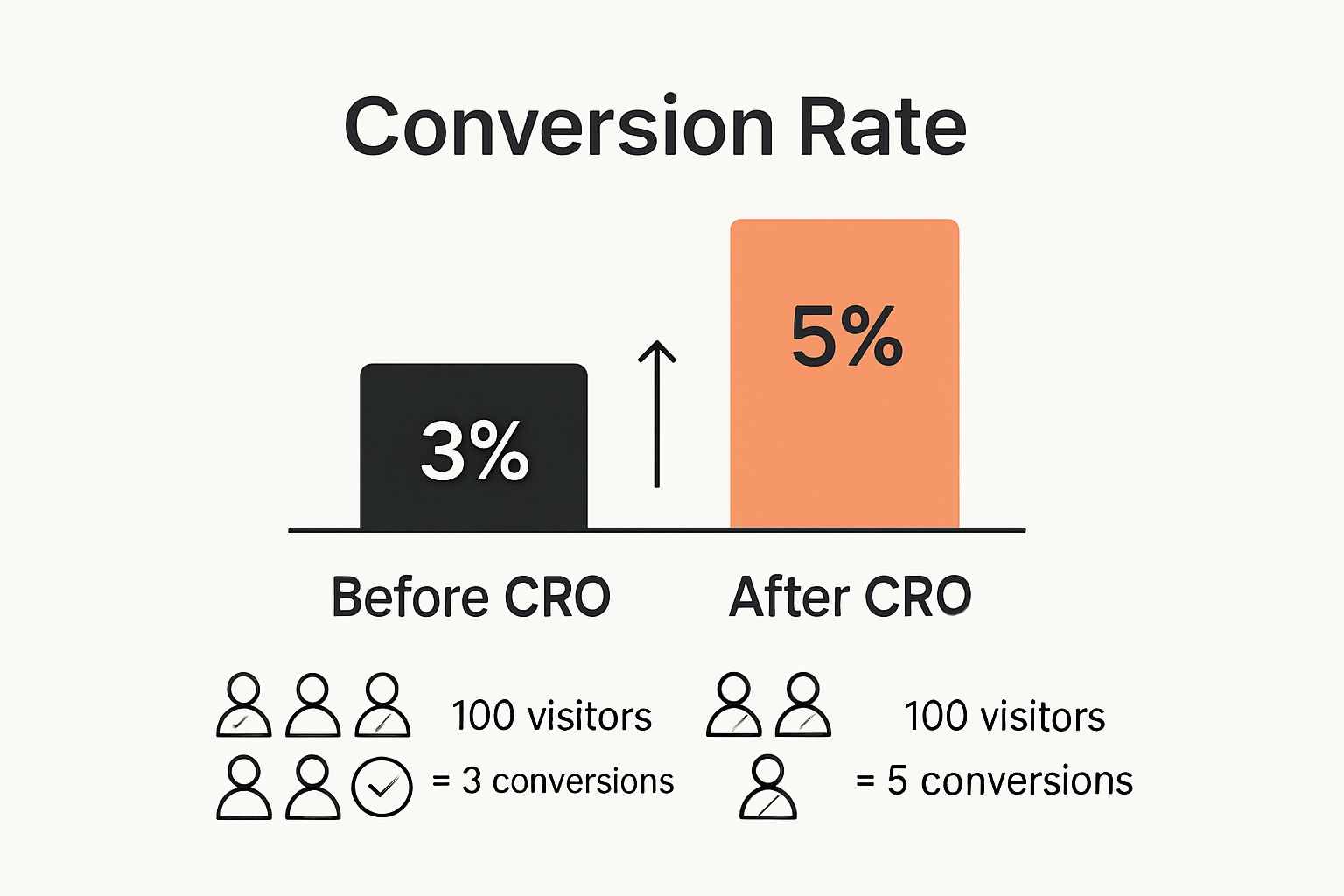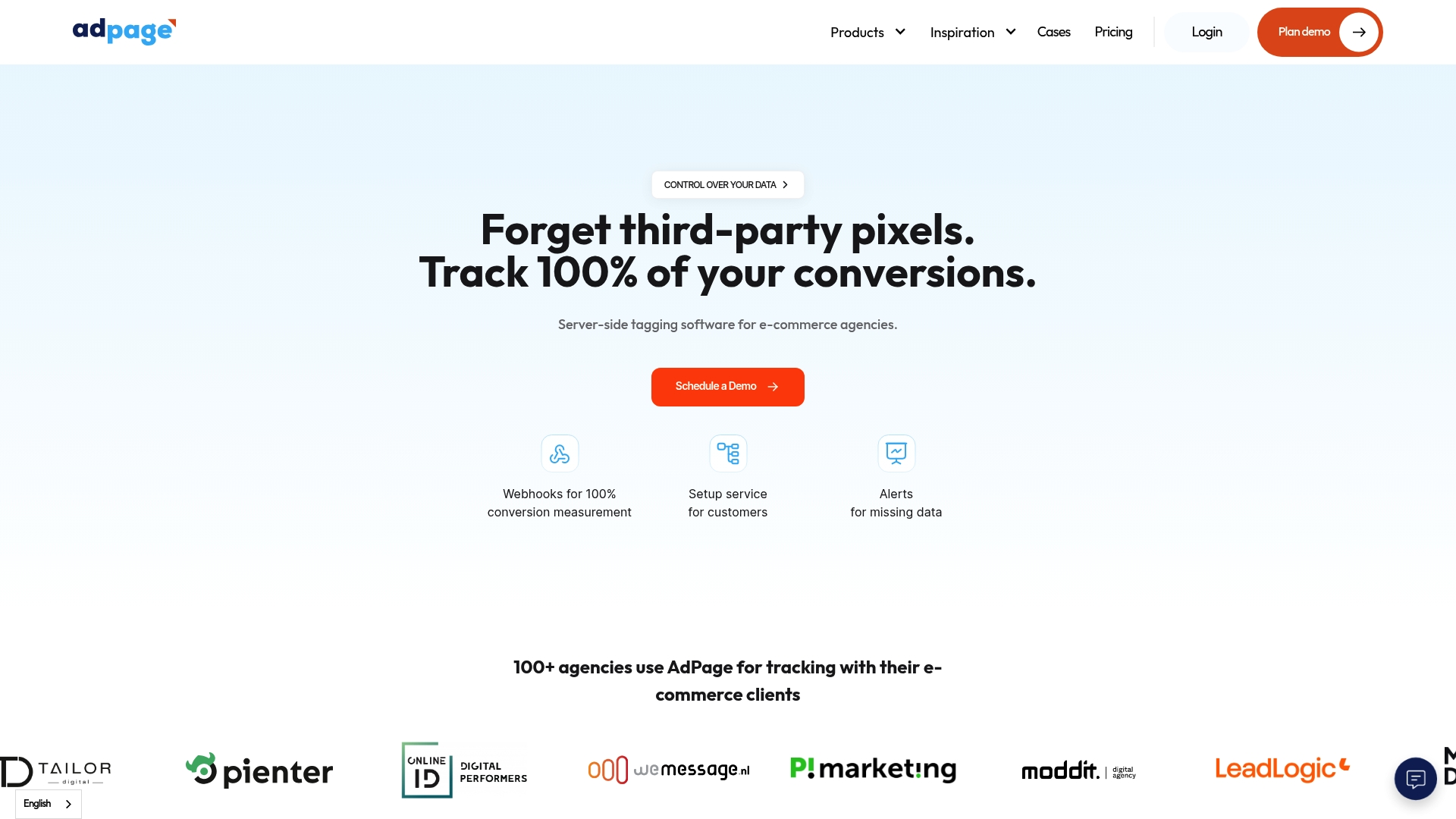Every business wants more people to buy, sign up, or engage on their website. A simple 10% to 30% improvement in conversion rate can mean thousands extra in revenue without spending an extra penny on traffic. You might expect fancy new ads or cutting-edge tech to be the main driver. The real secret sits within the structure of your site and the subtle ways users interact with it.
Tabla de contenido
- Defining Conversion Rate Optimization: The Basics
- The Importance of Conversion Rate Optimization in Digital Marketing
- How Conversion Rate Optimization Works: Key Components
- Measuring Success: Metrics and Analytics in Conversion Rate Optimization
- Real-World Applications: Conversion Rate Optimization Case Studies
Resumen rápido
| Llevar | Explicación |
|---|---|
| Understanding CRO boosts conversions | Conversion rate optimization transforms visitors into customers by enhancing user experiences and aligning them with business goals. |
| Focus on key conversion metrics | Track critical metrics like conversion rates and bounce rates to evaluate and improve website performance effectively. |
| Utilise data-driven insights | Collect and analyse user behaviour data to inform strategies that enhance user engagement and drive conversions. |
| A/B testing is essential | Implement A/B testing to make informed changes; compare versions of a webpage to discover what drives better results. |
| Continuous optimisation is crucial | Adopt an iterative approach to CRO, consistently refining your digital strategies to meet evolving user needs and preferences. |
Defining Conversion Rate Optimization: The Basics
Conversion rate optimization (CRO) is a systematic process of increasing the percentage of website visitors who take a desired action, such as purchasing a product, signing up for a service, or completing a form. At its core, CRO is about understanding user behaviour and creating digital experiences that encourage more visitors to convert from passive browsers to active customers.
Understanding Conversion Metrics
To comprehend CRO effectively, you must first understand conversion metrics. A conversion occurs when a website visitor completes a predefined goal that aligns with your business objectives. These goals can vary significantly across different industries and digital platforms:
- E-commerce: Completing a product purchase
- Service websites: Submitting an inquiry form
- SaaS platforms: Creating a user account
- Blog sites: Subscribing to a newsletter
The conversion rate is calculated by dividing the number of conversions by the total number of visitors and multiplying by 100. For instance, if 100 visitors arrive at your website and 5 make a purchase, your conversion rate would be 5%.
The Strategic Importance of CRO
Conversion rate optimization goes beyond simple numerical improvements. Our comprehensive guide on conversion strategies reveals that CRO is fundamentally about creating a more intuitive, user-friendly digital experience. By analysing user interactions, website design, content effectiveness, and technical performance, businesses can incrementally improve their online conversion potential.
Effective CRO involves multiple analytical approaches, including:
- User behaviour tracking: Understanding how visitors navigate and interact with your website
- A/B testing: Comparing different webpage versions to determine which generates more conversions
- User experience (UX) analysis: Identifying and removing obstacles that prevent smooth user journeys
The ultimate goal of conversion rate optimization is not just to increase numbers but to create a more meaningful, efficient connection between your digital platform and its potential customers.
The Importance of Conversion Rate Optimization in Digital Marketing
Conversion rate optimization represents a critical strategy for businesses seeking to maximise their digital marketing investments. By focusing on transforming website visitors into engaged customers, CRO provides a powerful mechanism for improving overall business performance and efficiency.
Economic Impact of Conversion Rate Optimization
In the competitive digital marketplace, CRO offers significant economic advantages. Improving conversion rates directly translates to increased revenue without necessarily increasing marketing expenditure. Instead of spending more on acquiring new traffic, businesses can extract greater value from their existing website visitors.
According to research from Econsultancy, companies investing in systematic CRO strategies can see conversion rate improvements ranging between 10% to 30%. These improvements can represent substantial financial gains with minimal additional marketing spend.
Strategic Performance Metrics
Conversion rate optimization provides businesses with comprehensive insights into their digital performance. Key strategic benefits include:
- Deeper understanding of customer behaviour and preferences
- Asignación más eficaz de los recursos de marketing
- Enhanced user experience design
- Improved return on digital marketing investments
Our comprehensive guide on conversion rate strategies highlights that successful CRO is not merely about increasing numbers but about creating meaningful interactions that align with customer expectations.
Long-Term Business Sustainability
Beyond immediate financial gains, conversion rate optimization contributes to long-term business sustainability. By continuously refining digital experiences, businesses can build stronger customer relationships, improve brand reputation, and create more predictable revenue streams. The iterative nature of CRO means that organizations can progressively enhance their digital platforms, staying responsive to changing user needs and technological advancements.
Ultimately, conversion rate optimization transforms digital marketing from a cost centre into a strategic asset, enabling businesses to compete more effectively in an increasingly digital marketplace.
How Conversion Rate Optimization Works: Key Components
Conversion rate optimization operates through a systematic, data-driven approach that transforms website performance by understanding and responding to user behaviour. The core principle of CRO involves continuous analysis, hypothesis generation, and strategic experimentation.
Recogida y análisis de datos
The foundational stage of CRO involves comprehensive data gathering and interpretation. Businesses collect information through multiple channels to develop a nuanced understanding of user interactions. Our conversion optimization tips guide emphasises the importance of leveraging diverse data sources.
Key data collection methods include:
- Web analytics tracking user journey and behaviour
- Heatmap technologies showing click patterns
- User session recordings
- Demographic and behavioural segmentation
- Análisis del embudo de conversión
Hypothesis Development and Testing
According to Optimizely’s optimization framework, effective CRO requires generating evidence-based hypotheses about potential improvements. This involves creating specific, measurable predictions about how website modifications might enhance user experience and conversion rates.
The testing process typically follows a structured approach:
- Formulate a clear hypothesis: What specific change might improve conversions?
- Design controlled experiments: Create A/B or multivariate tests
- Implement precise tracking mechanisms
- Statistical validation of results
- Implementation of validated improvements
Continuous Optimization and Iteration
Conversion rate optimization is not a one-time activity but an ongoing process of incremental improvements. Successful businesses treat their digital platforms as dynamic environments that require constant refinement. By consistently monitoring performance, gathering user feedback, and implementing data-driven adjustments, organizations can create progressively more effective digital experiences that resonate with their target audience.
Below is a table summarising key components and activities involved in each stage of the conversion rate optimisation (CRO) process for quick reference.
| CRO Stage | Actividades principales | Example Techniques |
|---|---|---|
| Recogida y análisis de datos | Gather and interpret user data | Web analytics, heatmaps, session recordings |
| Hypothesis Development | Generate data-driven improvement ideas | Identify issues, form clear hypothesis |
| Testing and Experimentation | Test changes using controlled experiments | A/B testing, multivariate testing |
| Implementación | Apply validated improvements to the website | Design changes, content updates |
| Continuous Optimisation | Monitor results and refine strategies iteratively | Ongoing analytics, feedback loops |
The ultimate goal remains transforming passive website visitors into engaged customers through strategic, scientifically informed design and user experience enhancements.
Measuring Success: Metrics and Analytics in Conversion Rate Optimization
Measuring success in conversion rate optimization requires a sophisticated approach that goes beyond simple numerical tracking. Analytics provide the critical insights that transform raw data into actionable strategic intelligence, enabling businesses to understand and improve their digital performance.
This table presents essential conversion metrics discussed in the article, clarifying their definitions and roles in measuring digital marketing performance.
| Métrica | Definición | Importancia |
|---|---|---|
| Tasa de conversión | Percentage of visitors completing a desired action | Core indicator of website effectiveness |
| Tasa de rebote | Percentage leaving after viewing only one page | Shows engagement and possible UX issues |
| Average Time on Page | Mean time users spend on a webpage | Indicates content relevance and engagement |
| Coste por adquisición | Average spend to gain a customer or lead | Measures marketing efficiency |
| Ingresos por visitante | Average revenue generated per website visitor | Assesses earning power of site traffic |
| Exit Page Rate | Frequency users leave from a specific page | Identifies potential weaknesses in the funnel |
Core Conversion Metrics
Successful CRO relies on identifying and tracking key performance indicators that reveal genuine user engagement. Our comprehensive guide on analytics metrics emphasises the importance of selecting meaningful measurements.
Essential conversion metrics include:
- Conversion rate percentage
- Tasa de rebote
- Average time on page
- Cost per acquisition
- Revenue per visitor
- Exit page rates
Advanced Analytics Techniques
According to Google Analytics expertise, advanced CRO measurement involves multilayered analytical approaches. Businesses must move beyond surface-level metrics to understand complex user interaction patterns.
Key advanced analytics techniques comprise:
- Funnel visualization: Tracking user progression through conversion stages
- Cohort analysis: Understanding behaviour of specific user groups
- Segmentation: Examining performance across different user demographics
- Goal tracking: Measuring specific predetermined conversion objectives
Interpreting and Applying Analytical Insights
The true power of conversion rate optimization analytics lies not in collecting data, but in transforming insights into strategic actions.
 Successful organizations use analytical findings to continuously refine their digital experiences, creating increasingly sophisticated user journeys that naturally guide potential customers towards conversion.
Successful organizations use analytical findings to continuously refine their digital experiences, creating increasingly sophisticated user journeys that naturally guide potential customers towards conversion.
By maintaining a data-driven, iterative approach, businesses can progressively enhance their digital platforms, turning analytical insights into tangible performance improvements.

Real-World Applications: Conversion Rate Optimization Case Studies
Conversion rate optimization transcends theoretical concepts, demonstrating tangible business transformation through strategic digital interventions. Real-world case studies illuminate how systematic CRO approaches can dramatically improve online performance across diverse industries and digital platforms.
E-commerce Performance Optimization
Our expert guide on increasing conversions highlights the substantial impact of targeted CRO strategies. In one remarkable example, an online fashion retailer implemented a comprehensive conversion optimization programme that yielded remarkable results.
Key improvements included:
- Streamlining product page design
- Simplifying checkout process
- Implementing trust signals
- Enhancing mobile responsiveness
- Personalizing product recommendations
Through these strategic modifications, the retailer experienced a 42% increase in conversion rates and a significant reduction in cart abandonment.
SaaS Platform User Acquisition
According to Conversion XL research, software-as-a-service platforms can achieve substantial user growth through meticulous CRO techniques. A notable case study involves a project management software company that redesigned its landing page and onboarding experience.
Their optimization strategy focused on:
- Reducing form complexity: Minimizing registration steps
- Clarifying value proposition: Creating more compelling messaging
- Implementing social proof: Adding customer testimonials
- Improving visual hierarchy: Guiding user attention
Financial Services Digital Transformation
Financial service providers have also leveraged conversion rate optimization to enhance digital customer experiences. By understanding user behaviour and implementing data-driven design changes, these organizations have successfully increased online engagement and transaction completion rates.
The most successful approaches combine technical optimization, psychological understanding, and continuous experimental refinement. Through persistent, strategic improvements, businesses can transform their digital platforms from passive websites into dynamic, high-performance customer acquisition engines.
Unlock the True Power of Conversion Rate Optimisation for Your Business
Are you struggling with inaccurate conversion metrics and frustrated by the limitations of traditional analytics? As discussed in our article on conversion rate optimisation, having the right data is crucial for making meaningful improvements. Many businesses face issues with data loss, unreliable tracking, and difficulty analysing user behaviour, which prevents them from maximising their potential and achieving higher conversion rates.

Experience the difference with AdPage, the platform built to empower e-commerce professionals and marketers with precise server-side tagging, consent management and 100% conversion tracking. Our advanced tools ensure accurate user data collection, simplify GDPR compliance, and integrate easily with leading e-commerce platforms, so you can confidently act on every insight. Discover how to turn your website visitors into loyal customers and begin your journey to higher ROI. Visit AdPage’s homepage today and see the impact of secure, reliable conversion tracking. Don’t let another valuable insight slip away – start optimising your results now.
Preguntas frecuentes
What is the main objective of Conversion Rate Optimization (CRO)?
The main objective of Conversion Rate Optimization (CRO) is to increase the percentage of website visitors who complete a desired action, such as making a purchase or signing up for a service, by enhancing the overall digital experience.
How is the conversion rate calculated?
The conversion rate is calculated by dividing the number of conversions by the total number of visitors to a website, then multiplying the result by 100. For example, if 100 visitors come to your site and 5 make a purchase, the conversion rate is 5%.
Why is Conversion Rate Optimization important for businesses?
CRO is crucial for businesses as it allows them to maximise the value of their existing traffic, increase conversion rates, and ultimately boost revenue without substantial increases in marketing costs. This leads to better overall business performance and efficiency.
What methods are used in Conversion Rate Optimization?
Common methods used in CRO include user behaviour tracking, A/B testing, and user experience (UX) analysis to identify obstacles in the user journey and implement necessary improvements.



.png)
